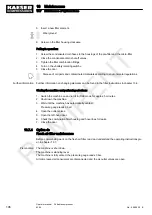
5. Tighten up the clamping bolts
5
with the self-locking nuts
6
.
It must be just possible to manually move the screw connections.
10.5 Cleaning the cooler
The frequency of cleaning is mainly dependent on local operating conditions.
Severe clogging of the coolers causes overheating and machine damage.
Check coolers regularly for clogging.
Avoid creating dust eddies. Wear breathing protection if necessary.
Do not clean the coolers/radiators with a sharp instrument as they may be damaged.
A severely contaminated cooler/radiator should be cleaned by KAESER SERVICE.
Material Compressed air
Breathing mask (if necessary)
Water or steam jet blaster
Precondition The machine is placed over a washing station equipped with an oil separator.
The machine is switched off.
The machine has cooled down.
The machine is fully vented, the pressure gauge reads 0 bar.
All compressed air consumers are disconnected and the air outlet valves are open.
The negative cable to the battery is disconnected.
NOTICE
Damage to the machine can be caused by water or steam jets.
Direct water or steam jets can damage or destroy electrical components and indicating in‐
struments.
➤ Cover up electrical components such as the control cabinet, alternator, starter and in‐
struments.
➤ Do not direct water or steam jets at sensitive components such as alternator, starter or
indicating instruments.
➤ Deploy the extension pole of the pressure washer at a distance of at least 50 cm and an
approximately 90° angle to the cooler/radiator surface.
➤ Open both doors.
10.5.1 Cleaning the compressor cooler and engine radiator
The compressor oil cooler and engine coolant radiator are combined in a single cooler block.
10 Maintenance
10.5 Cleaning the cooler
No.: 9_5898 26 E
Operator manual Portable compressor
M 64
137
RAMIRENT
















































